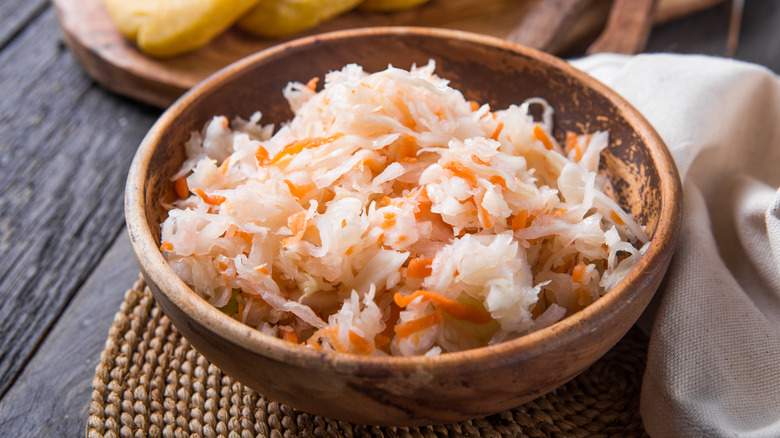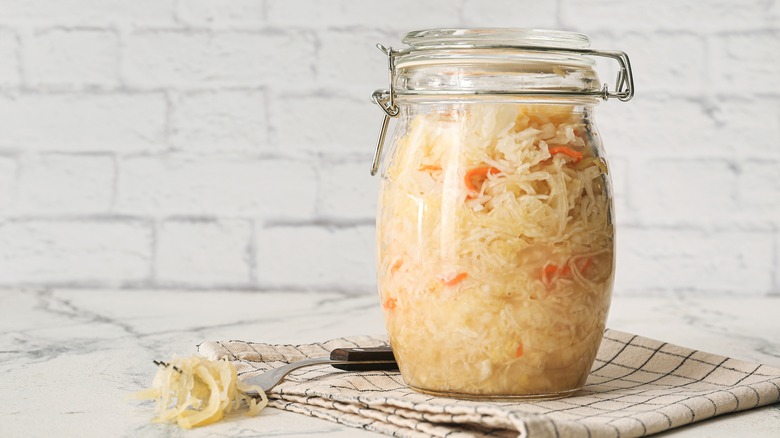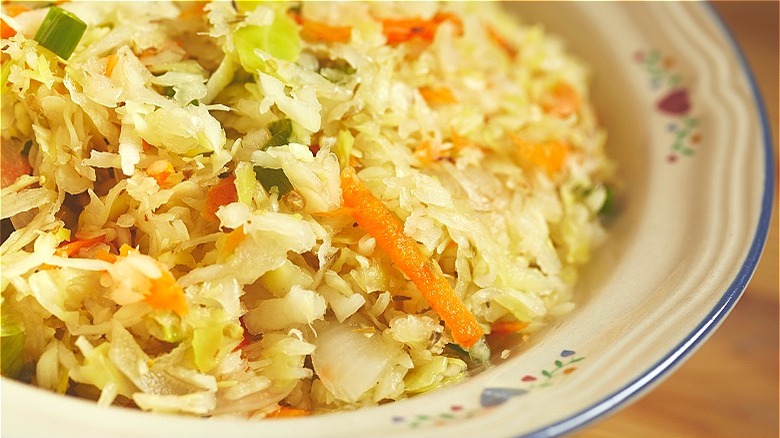Curtido: The Salvadoran Cabbage Slaw That Will Ignite Your Taste Buds
Many countries have a briny, crunchy vegetable dish that acts as a palate cleanser between bites of meats and starches. While anything with enough bite can be pickled or fermented, cabbage seems to be the cruciferous vegetable of choice: sauerkraut in Germany (although rooted in Chinese cuisine per German Foods), kimchi in Korea, koolsla (or coleslaw as we know it today) in the Netherlands. It's intuitive since cabbage has the crunch of more fibrous greens without the stringy texture. Plus, on its own, cabbage has a sulfurous, bitter aftertaste that should be expelled or at least overridden with vinegar and salt, per Foodiosity.
The curtido is the Salvadoran version of the shapeshifting salty cabbage. Taste Atlas says it is a lightly-fermented cabbage, carrot, and onion medley that may or may not include other vegetables like jalapeño or cauliflower. As with most cabbage sides, curtido is traditionally served with a heavy savory counterpart, pupusas, the national dish of El Salvador (via Solid Ground).
Origin of the curtido
It's hard to trace the origin of the curtido with its mixed history of cabbage and being eaten with vinegar. 196 Flavors notes that curtido is consumed throughout Central America but is most popularly known for being a Salvadoran dish. Cabbage was brought from Europe to the Americas by French explorer Jacques Cartier in the mid-16th century, per Aggie Horticulture. Exploration helped spread the cabbage throughout the world, with variations of the same cabbage dishes. The Dutch koolsla, from which coleslaw originates, is one of many instances. While the koolsla is a cabbage salad, the curtido is a fermented cabbage relish that requires a little more patience.
Every civilization has had some fermentation process for preserving their food, and fermented cabbage is a common dish shared across cultures across the globe, per Food and Nutrition. The curtido is often compared to the Haitian pikliz, which is a spicy pickled cabbage relish made from similar ingredients and processes, as shown in the Journal of Ethnic Foods.
Simply sliced and made with patience
Curtido is quite simple to make but can take some time. It calls for three main ingredients: cabbage, onions, and carrots (via Taste Atlas). The cabbage is thinly sliced into small strips, which is more easily done with a mandoline slicer per Girl with Spoon. Some traditional curtido recipes call for finely minced cabbage, which makes it look more like salsa or condiment than a salad. The carrots and onions are sliced or julienned into thin strips to create a homogenous textured slaw.
Then, the prepared vegetables are placed into a sealable glass jar for fermentation. Recetas Salvadoreñas' recipe calls for a concoction of boiling water, chicken stock, a little bit of yellow or pineapple vinegar, and herbs like bay leaf. The curtido is left to ferment in this mixture for at least four hours, but the longer you wait, the better it tastes. Another recipe by Serious Eats is said to be a quicker curtido that only takes a little over an hour. Still, it heavily depends on the acidity of the vinegar, which makes it more of a pickled cabbage than fermented.
Is curtido fermented or pickled?
Curtido is technically fermented, but it's difficult to say, considering how it is made. Pickling is done with an acidic element like vinegar, whereas fermentation is supposed to create a similar effect with natural sugars and bacteria that are present in the ingredients, per Webstaurant Store. However, most curtido recipes do include vinegar, which can make this a bit confusing.
Here's the thing: Although traditional curtido recipes use vinegar, it isn't doing the leg work of pickling the vegetables. Most of the time, the curtido uses less acidic kinds of vinegar like apple cider vinegar, which actually aids the fermentation process thanks to the presence of healthy bacteria, per Fermentation Hero. So even if vinegar is added to the curtido, it is still being fermented rather than pickled (as long as you don't add too much). If you're in a pinch for time, there is no shame in pickling your vegetables instead.



